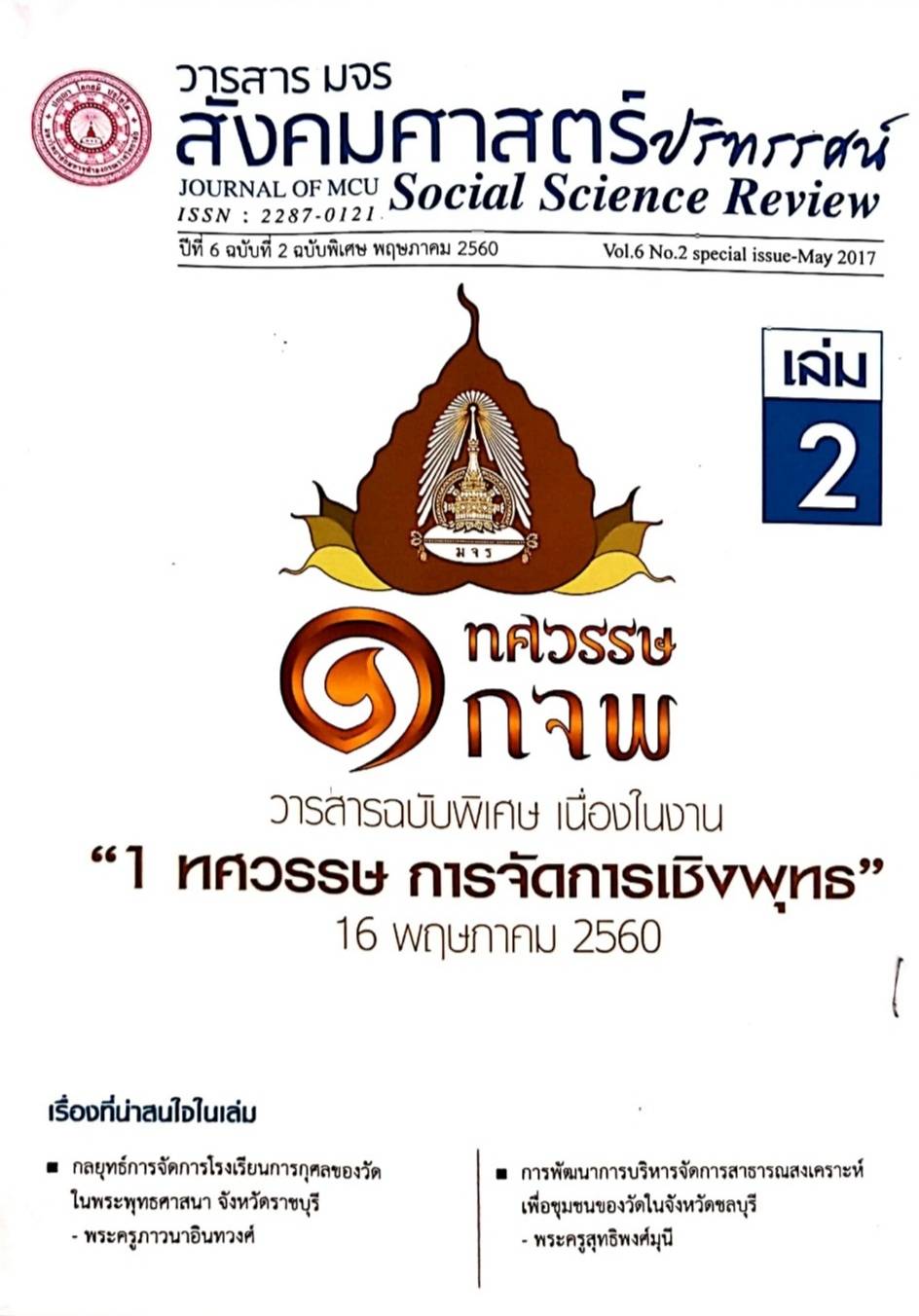มัชฌิมาปฏิปทาในการปฏิบัติวิปัสสนาตามหลักสติปัฏฐาน 4
คำสำคัญ:
มัชฌิมาปฏิปทา; การปฏิบัติวิปัสสนา; สติปัฏฐาน 4.บทคัดย่อ
มัชฌิมาปฏิปทา ซึ่งเป็นทางสายกลางในอริยมรรคมีองค์ 8 เป็นหลักธรรมที่สาคัญที่ปรากฏในมหาโคปาลสูตร เรียกว่าเป็นแนวทางการปฏิบัติเพื่อทาความสิ้นไปแห่งทุกข์ทั้งปวงมัชฌิมาปฏิปทา ได้ชื่อว่า อริยมรรค คือ หนทางปฏิบัติของพระอริยบุคคล ประกอบด้วยองค์ 8 คือ1) สัมมาทิฏฐิ เห็นชอบ 2) สัมมาสังกัปปะ ดาริชอบ 3) สัมมาวาจาเจรจาชอบ 4) สัมมากัมมันตะกระทาชอบ 5) สัมมาอาชีวะ เลี้ยงชีพชอบ 6) สัมมาวายามะ พยายามชอบ 7) สัมมาสติ ระลึกชอบ 8) สัมมาสมาธิ ตั้งจิตมั่นชอบ โดยองค์ธรรมคือตัวปัญญา จัดเป็นปัญญาเจตสิกธรรม ส่วนมรรค 7 ประการที่เหลือเป็นมรรคที่สนับสนุนให้เกิดสัมมาทิฏฐิการปฏิบัติวิปัสสนาภาวนาในทางพระพุทธศาสนาหมายถึง การปฏิบัติในหลักสัมมาสติคือการเจริญสติโดยชอบใน 4 ฐานคือ กายานุปัสสนาสติปัฏฐาน คือสติที่เข้าไปตั้งมั่นในกายเวทนานุปัสสนาสติปัฏฐาน คือสติที่เข้าไปตั้งมั่นในเวทนา จิตตานุปัสสนาสติปัฏฐาน คือสติที่เข้าไปตั้งมั่นในจิตและธรรมานุปัสสนาสติปัฏฐาน คือสติที่เข้าไปตั้งมั่นในธรรมทั้งหลาย การปฏิบัติตามสติปัฏฐาน 4 นี้ เป็นหนทางเดียวเท่านั้นที่ทาให้ภพ ชาติ และสังสารวัฏสิ้นไปการเจริญสติปัฏฐานต้องมี วิริยะ สติ สมาธิ และ ปัญญา หรือเจริญมรรคมีองค์ 8 อันเป็นมัชฌิมาปฏิปทา (ข้อปฏิบัติอันเป็นทางสายกลาง) เมื่อผู้ปฏิบัติธรรมดาเนินไปตามทางสายกลางแล้วตั้งสติระลึกรู้สภาวธรรม (รูปนาม) ปัจจุบันที่ปรากฏทางทวารทั้ง 6 ก็จะเห็นทุกสิ่งตามความเป็นจริง เกิดญาณปัญญาที่รู้แจ้งพระนิพพาน
เอกสารอ้างอิง
พระพรหมคุณาภรณ์ (ป.อ. ปยุตฺโต). พจนานุกรมพุทธศาสตร์ ฉบับประมวลธรรม. พิมพ์ครั้งที่ 10.กรุงเทพมหานคร: โรงพิมพ์ บริษัท เอส.อาร์.พริ้นติ้ง แมส โปรดักส์ จาจัด, 2548.
_________.พุทธธรรม ฉบับปรับปรุงและขยายความ. พิมพ์ครั้งที่ 7. กรุงเทพมหานคร: โรงพิมพ์มหาวิทยาลัยมหาจุฬาลงกรณราชวิทยาลัย, 2541.
พระธรรมกิตติวงศ์ (ทองดี สุรเตโช). พจนานุกรมเพื่อการศึกษาพุทธศาสน์คาวัดที่ชาวพุทธควรรู้.พิมพ์ครั้งที่ 3. กรุงเทพมหานคร: โรงพิมพ์ ธรรมสภาและสถาบันบันลือธรรม 2551.
พระพุทธโฆสเถระ. วิสุทธิมรรค. พิมพ์ครั้งที่ 6. แปลโดย สมเด็จพระพุฒาจารย์ (อาจ อาสภมหาเถร). กรุงเทพมหานคร: บริษัท ธนาเพรส จากัด, 2548.
พระโสภณมหาเถระ (มหาสีสยาดอ). มหาสติปัฏฐานสูตรทางสู่พระนิพพาน, หน้า 252.
มหาจุฬาลงกรณราชวิทยาลัย. พระไตรปิฎกภาษาไทย ฉบับมหาจุฬาลงกรณราชวิทยาลัย. กรุงเทพมหานคร: โรงพิมพ์มหาจุฬาลงกรณราชวิทยาลัย, 2539.
ดาวน์โหลด
เผยแพร่แล้ว
รูปแบบการอ้างอิง
ฉบับ
ประเภทบทความ
สัญญาอนุญาต
ลิขสิทธิ์ (c) 2020 วารสาร มจร สังคมศาสตร์ปริทรรศน์

อนุญาตภายใต้เงื่อนไข Creative Commons Attribution-NonCommercial-NoDerivatives 4.0 International License.
เพื่อให้เป็นไปตามกฎหมายลิขสิทธิ์ ผู้นิพนธ์ทุกท่านต้องลงลายมือชื่อในแบบฟอร์มใบมอบลิขสิทธิ์บทความให้แก่วารสารฯ พร้อมกับบทความต้นฉบับที่ได้แก้ไขครั้งสุดท้าย นอกจากนี้ ผู้นิพนธ์ทุกท่านต้องยืนยันว่าบทความต้นฉบับที่ส่งมาตีพิมพ์นั้น ได้ส่งมาตีพิมพ์เฉพาะในวารสาร มจร สังคมศาสตร์ปริทรรศน์ เพียงแห่งเดียวเท่านั้น หากมีการใช้ภาพหรือตารางหรือเนื้อหาอื่นๆ ของผู้นิพนธ์อื่นที่ปรากฏในสิ่งตีพิมพ์อื่นมาแล้ว ผู้นิพนธ์ต้องขออนุญาตเจ้าของลิขสิทธิ์ก่อน พร้อมทั้งแสดงหนังสือที่ได้รับการยินยอมต่อบรรณาธิการ ก่อนที่บทความจะได้รับการตีพิมพ์ หากไม่เป็นไปตามข้อกำหนดเบื้องต้น ทางวารสารจะถอดบทความของท่านออกโดยไม่มีข้อยกเว้นใดๆ ทั้งสิ้น





